Combining Re-Analyzed Climate Data and Landcover Products to Assess the Temporal Complementarity of Wind and Solar Resources in Iraq
Abstract
:1. Introduction
2. Materials and Methods
2.1. Wind–Solar Resources Dataset
2.2. Wind Speed Extrapolation
2.2.1. Power LAW
2.2.2. Land Cover Analyses for WSC
2.2.3. WSC Validation
- Calculation of the average wind speed for each grid cell on the basis of the collected MERRA-2 data.
- Extrapolation of the average wind speed for each cell at a height of 100 m using Equation (1) and the WSC values derived from the land cover.
- Re-computation of the previous step using the experimental WSC value of 1/7.
- Extraction of the wind speed for each cell on the basis of the GEOSUN map of 100 m altitude, as shown in Figure 4. This requires calculating the mean value of the GEOSUN pixels within each cell using the Zonal Statistics tool with the Mean function.
- Calculation of the mean bias and the RMSE for both extrapolation attempts is as follows [40]:where and indicate the extrapolated and GEOSUN wind data, respectively.
2.3. Wind–Solar Resource Mapping
2.4. Wind–Solar Resources Complementarity Assessment
2.4.1. Timescale
2.4.2. Complementarity Index
3. Results and Discussion
3.1. WSC Map
3.2. Potentials of WSR in Iraq
3.3. Monthly Cycle Complementarity on a Daily Timescale
3.4. Effective Complementarity
4. Conclusions
Supplementary Materials
Author Contributions
Funding
Institutional Review Board Statement
Informed Consent Statement
Data Availability Statement
Acknowledgments
Conflicts of Interest
References
- Schindler, D.; Behr, H.D.; Jung, C. On the spatiotemporal variability and potential of complementarity of wind and solar resources. Energy Convers. Manag. 2020, 218, 113016. [Google Scholar] [CrossRef]
- Ren, G.; Wan, J.; Liu, J.; Yu, D. Spatial and temporal assessments of complementarity for renewable energy resources in China. Energy 2019, 177, 262–275. [Google Scholar] [CrossRef]
- Henao, F.; Viteri, J.P.; Rodríguez, Y.; Gómez, J.; Dyner, I. Annual and interannual complementarities of renewable energy sources in Colombia. Renew. Sustain. Energy Rev. 2020, 134, 110318. [Google Scholar] [CrossRef]
- Yan, J.; Qu, T.; Han, S.; Liu, Y.; Lei, X.; Wang, H. Reviews on characteristic of renewables: Evaluating the variability and complementarity. Int. Trans. Electr. Energy Syst. 2020, 30, e12281. [Google Scholar] [CrossRef]
- Gallardo, R.P.; Ríos, A.M.; Ramírez, J.S. Analysis of the solar and wind energetic complementarity in Mexico. J. Clean. Prod. 2020, 268, 122323. [Google Scholar] [CrossRef]
- Jurasz, J.; Canales, F.A.; Kies, A.; Guezgouz, M.; Beluco, A. A review on the complementarity of renewable energy sources: Concept, metrics, application and future research directions. Sol. Energy 2020, 195, 703–724. [Google Scholar] [CrossRef]
- Xu, L.; Wang, Z.; Liu, Y. The spatial and temporal variation features of wind-sun complementarity in China. Energy Convers. Manag. 2017, 154, 138–148. [Google Scholar] [CrossRef]
- Zhang, H.; Cao, Y.; Zhang, Y.; Terzija, V. Quantitative synergy assessment of regional wind-solar energy resources based on MERRA reanalysis data. Appl. Energy 2018, 216, 172–182. [Google Scholar] [CrossRef]
- Solomon, A.A.; Kammen, D.M.; Callaway, D. Investigating the impact of wind-solar complementarities on energy storage requirement and the corresponding supply reliability criteria. Appl. Energy 2016, 168, 130–145. [Google Scholar] [CrossRef] [Green Version]
- Mohammadi, K.; Goudarzi, N. Study of inter-correlations of solar radiation, wind speed and precipitation under the influence of El Niño Southern Oscillation (ENSO) in California. Renew. Energy 2018, 120, 190–200. [Google Scholar] [CrossRef]
- Gallardo, R.P.; Castro, A.O.; Ríos, A.M. An image processing-based method to assess the monthly energetic complementarity of solar and wind energy in Colombia. Energies 2020, 13, 1033. [Google Scholar] [CrossRef] [Green Version]
- Prasad, A.A.; Taylor, R.A.; Kay, M. Assessment of solar and wind resource synergy in Australia. Appl. Energy 2017, 190, 354–367. [Google Scholar] [CrossRef]
- D’Isidoro, M.; Briganti, G.; Vitali, L.; Righini, G.; Adani, M.; Guarnieri, G.; Moretti, L.; Raliselo, M.; Mahahabisa, M.; Ciancarella, L.; et al. Estimation of solar and wind energy resources over Lesotho and their complementarity by means of WRF yearly simulation at high resolution. Renew. Energy 2020, 158, 114–129. [Google Scholar] [CrossRef]
- Guezgouz, M.; Jurasz, J.; Chouai, M.; Bloomfield, H.; Bekkouche, B. Assessment of solar and wind energy complementarity in Algeria. Energy Convers. Manag. 2021, 238, 114170. [Google Scholar] [CrossRef]
- Jurasz, J.; Mikulik, J.; Dąbek, P.B.; Guezgouz, M.; Kaźmierczak, B. Complementarity and ‘resource droughts’ of solar and wind energy in poland: An era5-based analysis. Energies 2021, 14, 1118. [Google Scholar] [CrossRef]
- Berger, M.; Radu, D.; Fonteneau, R.; Henry, R.; Glavic, M.; Fettweis, X.; Le Du, M.; Panciatici, P.; Balea, L.; Ernst, D. Critical time windows for renewable resource complementarity assessment. Energy 2020, 198, 117308. [Google Scholar] [CrossRef] [Green Version]
- Weschenfelder, F.; de Novaes Pires Leite, G.; Araújo da Costa, A.C.; de Castro Vilela, O.; Ribeiro, C.M.; Villa Ochoa, A.A.; Araújo, A.M. A review on the complementarity between grid-connected solar and wind power systems. J. Clean. Prod. 2020, 257, 120617. [Google Scholar] [CrossRef]
- Kapica, J.; Canales, F.A.; Jurasz, J. Global atlas of solar and wind resources temporal complementarity. Energy Convers. Manag. 2021, 246, 114692. [Google Scholar] [CrossRef]
- Li, J.; Wang, X.; Yu, X.B. Use of spatio-temporal calibrated wind shear model to improve accuracy of wind resource assessment. Appl. Energy 2018, 213, 469–485. [Google Scholar] [CrossRef]
- Chaichan, M.T.; Kazem, H.A. Generating Electricity Using Photovoltaic Solar Plants in Iraq; Springer International Publishing AG: Cham, Switzerland, 2018; ISBN 9783319750316. [Google Scholar]
- Al-Kayiem, H.H.; Mohammad, S.T. Potential of renewable energy resources with an emphasis on solar power in Iraq: An outlook. Resources 2019, 8, 42. [Google Scholar] [CrossRef] [Green Version]
- Saeed, I.M.; Ramli, A.T.; Saleh, M.A. Assessment of sustainability in energy of Iraq, and achievable opportunities in the long run. Renew. Sustain. Energy Rev. 2016, 58, 1207–1215. [Google Scholar] [CrossRef]
- Istepanian, H. Solar Energy in Iraq: From Outset to Offset; Iraq Energy Institute: Baghdad, Iraq, 2018. [Google Scholar]
- Resen, A.K.; Khamees, A.B.; Yaseen, S.F. Determination of Wind Shear Coefficients and Conditions of Atmospheric Stability for Three Iraqi Sites. In Proceedings of the IOP Conference Series: Materials Science and Engineering, Baghdad, Iraq, 15 April 2020. [Google Scholar]
- NASA Goddard Earth Sciences Data and Information Services Center (GES DISC). Available online: https://disc.gsfc.nasa.gov/ (accessed on 28 June 2021).
- Gueymard, C.A.; Yang, D. Worldwide validation of CAMS and MERRA-2 reanalysis aerosol optical depth products using 15 years of AERONET observations. Atmos. Environ. 2020, 225, 117216. [Google Scholar] [CrossRef]
- Rabbani, R.; Zeeshan, M. Exploring the suitability of MERRA-2 reanalysis data for wind energy estimation, analysis of wind characteristics and energy potential assessment for selected sites in Pakistan. Renew. Energy 2020, 154, 1240–1251. [Google Scholar] [CrossRef]
- Richardson, D.B.; Andrews, R.W. Validation of the MERRA dataset for solar PV applications. In Proceedings of the 2014 IEEE 40th Photovoltaic Specialist Conference, PVSC 2014, Denver, CO, USA, 8–13 June 2014. [Google Scholar]
- Monforti, F.; Huld, T.; Bódis, K.; Vitali, L.; D’Isidoro, M.; Lacal-Arántegui, R. Assessing complementarity of wind and solar resources for energy production in Italy. A Monte Carlo approach. Renew. Energy 2014, 63, 576–586. [Google Scholar] [CrossRef]
- International Electrotechnical Commission. Part 12-1: Power performance measurements of electricity producing wind turbines. In IEC TC/SC 88. Technical Report IEC; International Electrotechnical Commission: Geneva, Switzerland, 2005. [Google Scholar]
- Hellmann, G. Über die Bewegung der Luft in den Untersten Schichten der Atmosphäre; Kgl. Akademie der Wissenschaften [G.] Reimer: Berlin, Germany, 1914. [Google Scholar]
- Chaudhry, Q.Z. An investigation on wind power potential of Gharo-Sindh, Pakistan. Pakistan J. Meteorol. 2009, 6, 1–11. [Google Scholar]
- Masters, G.M. Renewable and Efficient Electric Power Systems; John Wiley & Sons: Hoboken, NJ, USA, 2013; ISBN 1118633490. [Google Scholar]
- Aghbalou, N.; Charki, A.; Elazzouzi, S.R.; Reklaoui, K. A probabilistic assessment approach for wind turbine-site matching. Int. J. Electr. Power Energy Syst. 2018, 103, 497–510. [Google Scholar] [CrossRef]
- Hadi, F.A. Diagnosis of the Best Method for Wind Speed Extrapolation. Int. J. Adv. Res. Electr. 2015, 4, 8177–8183. [Google Scholar]
- Nayyar, Z.A.; Ali, A. Roughness classification utilizing remote sensing techniques for wind resource assessment. Renew. Energy 2020, 149, 66–79. [Google Scholar] [CrossRef]
- Esri 10-Meter Land Cover. Available online: https://livingatlas.arcgis.com/landcover/ (accessed on 6 August 2021).
- Esri 2020 Land Cover–Overview. Available online: https://www.arcgis.com/home/item.html?id=d6642f8a4f6d4685a24ae2dc0c73d4ac (accessed on 6 August 2021).
- Abdul wahab, R.A.; Nassir, S.T.; Hadi, F.A. Number of Electricity Hours Generation Map for Different Wind Turbines in the Province of Wasit—Iraq. Iraqi J. Sci. 2019, 60, 1259–1265. [Google Scholar] [CrossRef]
- Miao, H.; Dong, D.; Huang, G.; Hu, K.; Tian, Q.; Gong, Y. Evaluation of Northern Hemisphere surface wind speed and wind power density in multiple reanalysis datasets. Energy 2020, 200, 117382. [Google Scholar] [CrossRef]
- Chancham, C.; Waewsak, J.; Gagnon, Y. Offshore wind resource assessment and wind power plant optimization in the Gulf of Thailand. Energy 2017, 139, 706–731. [Google Scholar] [CrossRef]
- Canales, F.A.; Jurasz, J.; Beluco, A.; Kies, A. Assessing temporal complementarity between three variable energy sources through correlation and compromise programming. Energy 2020, 192, 116637. [Google Scholar] [CrossRef] [Green Version]
- Slusarewicz, J.H.; Cohan, D.S. Assessing solar and wind complementarity in Texas. Renew. Wind. Water Sol. 2018, 5, 7. [Google Scholar] [CrossRef] [Green Version]
- Vega-Sanchez, M.A.; Castaneda-Jimenez, P.D.; Pena-Gallardo, R.; Ruiz-Alonso, A.; Morales-Saldana, J.A.; Palacios-Hernandez, E.R. Evaluation of complementarity of wind and solar energy resources over Mexico using an image processing approach. In Proceedings of the 2017 IEEE International Autumn Meeting on Power, Electronics and Computing, ROPEC 2017, Ixtapa, Mexico, 8–10 November 2017. [Google Scholar]
- Naeem, A.; Hassan, N.U.; Yuen, C.; Muyeen, S.M. Maximizing the economic benefits of a grid-tied microgrid using solar-wind complementarity. Energies 2019, 12, 395. [Google Scholar] [CrossRef] [Green Version]
- Aza-Gnandji, M.; Fifatin, F.X.; Hounnou, A.H.J.; Dubas, F.; Chamagne, D.; Espanet, C.; Vianou, A. Complementarity between Solar and Wind Energy Potentials in Benin Republic. Adv. Eng. Forum 2018, 28, 128–138. [Google Scholar] [CrossRef] [Green Version]
- Zhu, Y.; Chen, S.; Huang, W.; Wang, L.; Ma, G. Complementary operational research for a hydro-wind-solar hybrid power system on the upper Jinsha River. J. Renew. Sustain. Energy 2018, 10, 043309. [Google Scholar] [CrossRef]
- Jurasz, J.; Beluco, A.; Canales, F.A. The impact of complementarity on power supply reliability of small scale hybrid energy systems. Energy 2018, 161, 737–743. [Google Scholar] [CrossRef]
- Shaner, M.R.; Davis, S.J.; Lewis, N.S.; Caldeira, K. Geophysical constraints on the reliability of solar and wind power in the United States. Energy Environ. Sci. 2018, 11, 914–925. [Google Scholar] [CrossRef] [Green Version]
- Bashaer, M.; Abdullah, O.I.; Al-Tmimi, A.I. Investigation and analysis of wind turbines optimal locations and performance in Iraq. FME Trans. 2020, 48, 155–163. [Google Scholar] [CrossRef]
- Abd Ali, L.M.; Al-Rufaee, F.M.; Kuvshinov, V.V.; Krit, B.L.; Al-Antaki, A.M.; Morozova, N.V. Study of Hybrid Wind–Solar Systems for the Iraq Energy Complex. Appl. Sol. Energy (Engl. Transl. Geliotekhnika) 2020, 56, 284–290. [Google Scholar] [CrossRef]
- Krzywinski, M.; Altman, N. Points of significance: Significance, P values and t-tests. Nat. Methods 2013, 10, 1041–1042. [Google Scholar] [CrossRef] [Green Version]
- Aziz, A.S.; Tajuddin, M.F.N.; Adzman, M.R.; Mohammed, M.F.; Ramli, M.A.M. Feasibility analysis of grid-connected and islanded operation of a solar PV microgrid system: A case study of Iraq. Energy 2020, 191, 116591. [Google Scholar] [CrossRef]
- Obane, H.; Nagai, Y.; Asano, K. Assessing land use and potential conflict in solar and onshore wind energy in Japan. Renew. Energy 2020, 160, 842–851. [Google Scholar] [CrossRef]
- Koc, A.; Turk, S.; Şahin, G. Multi-criteria of wind-solar site selection problem using a GIS-AHP-based approach with an application in Igdir Province/Turkey. Environ. Sci. Pollut. Res. 2019, 26, 32298–32310. [Google Scholar] [CrossRef] [PubMed]
- Chu, C.T.; Hawkes, A.D. A geographic information system-based global variable renewable potential assessment using spatially resolved simulation. Energy 2020, 193, 116630. [Google Scholar] [CrossRef]
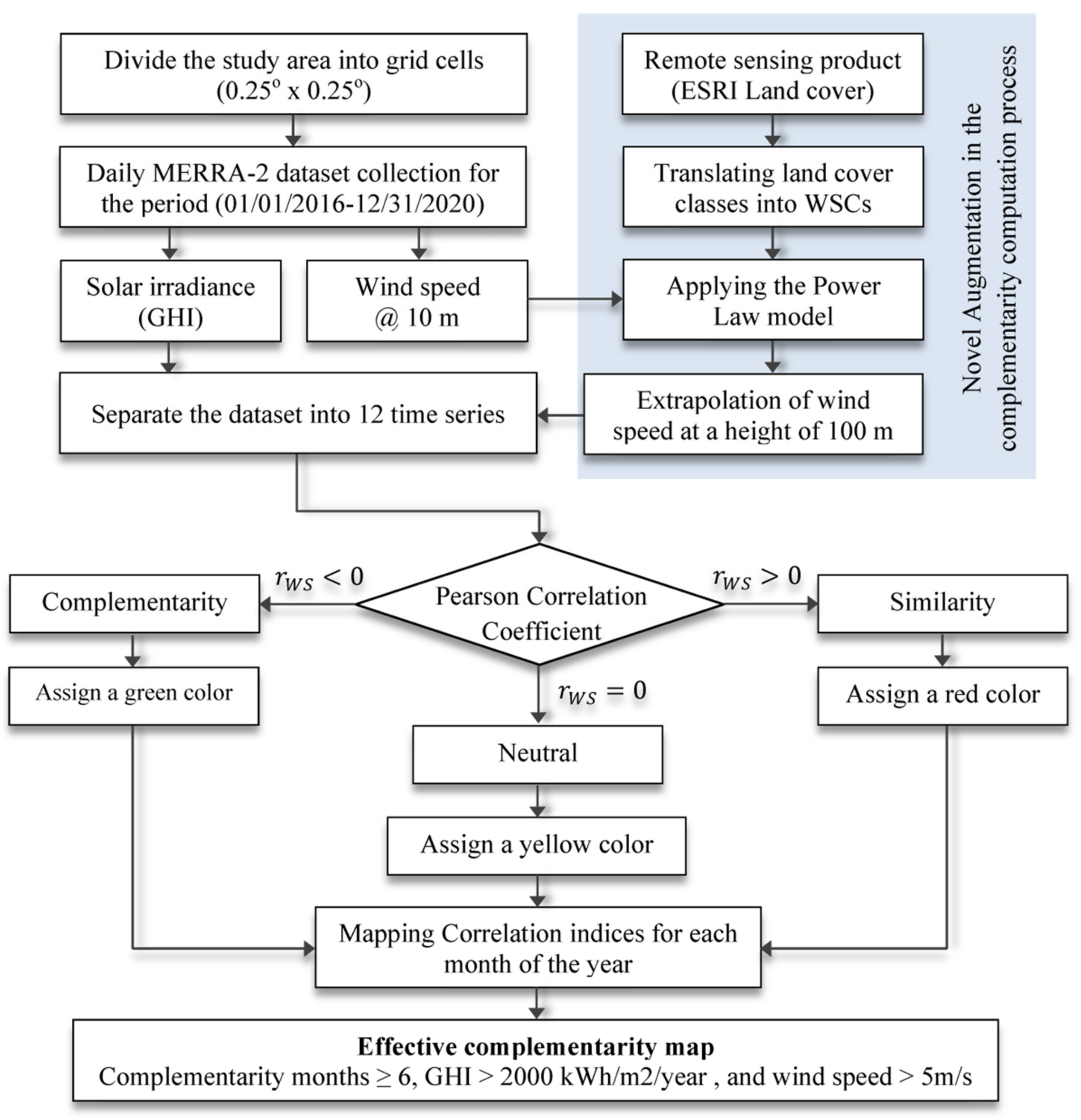

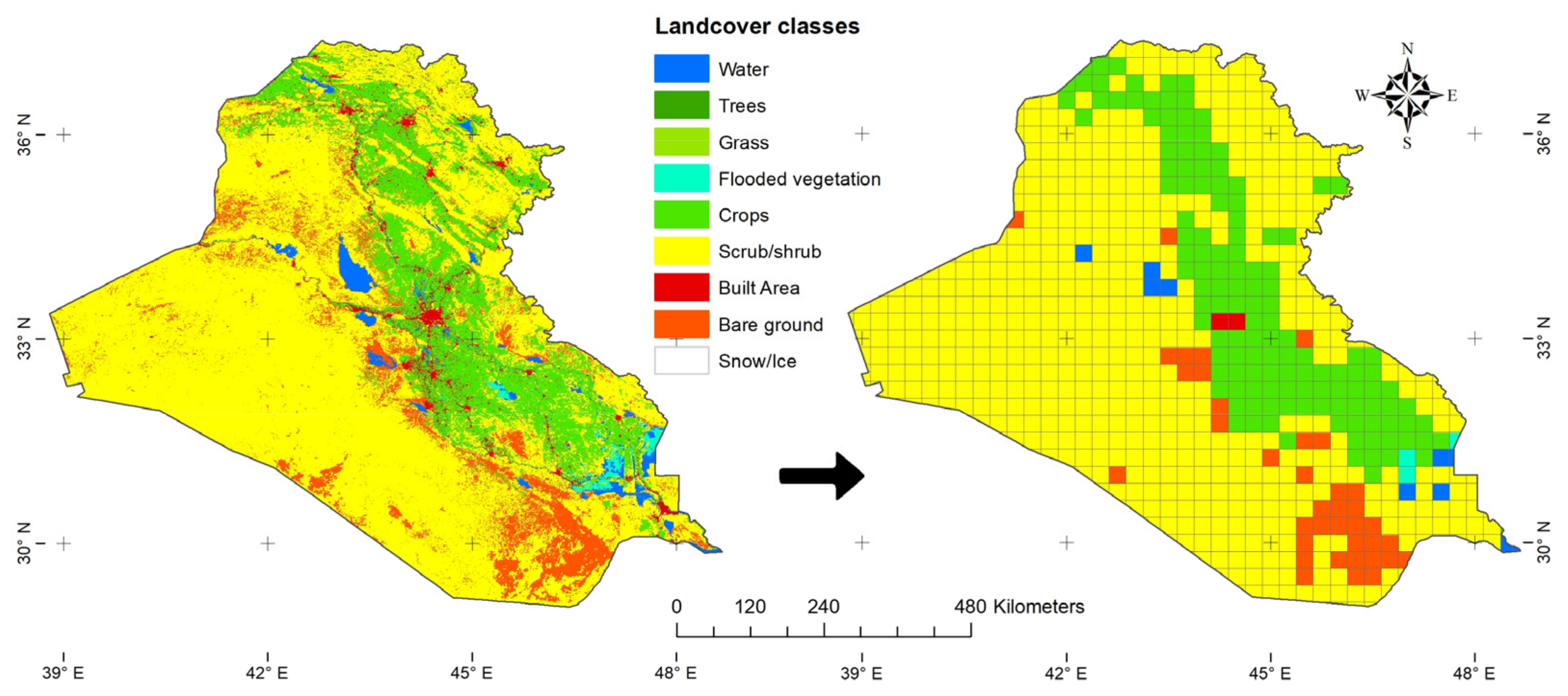
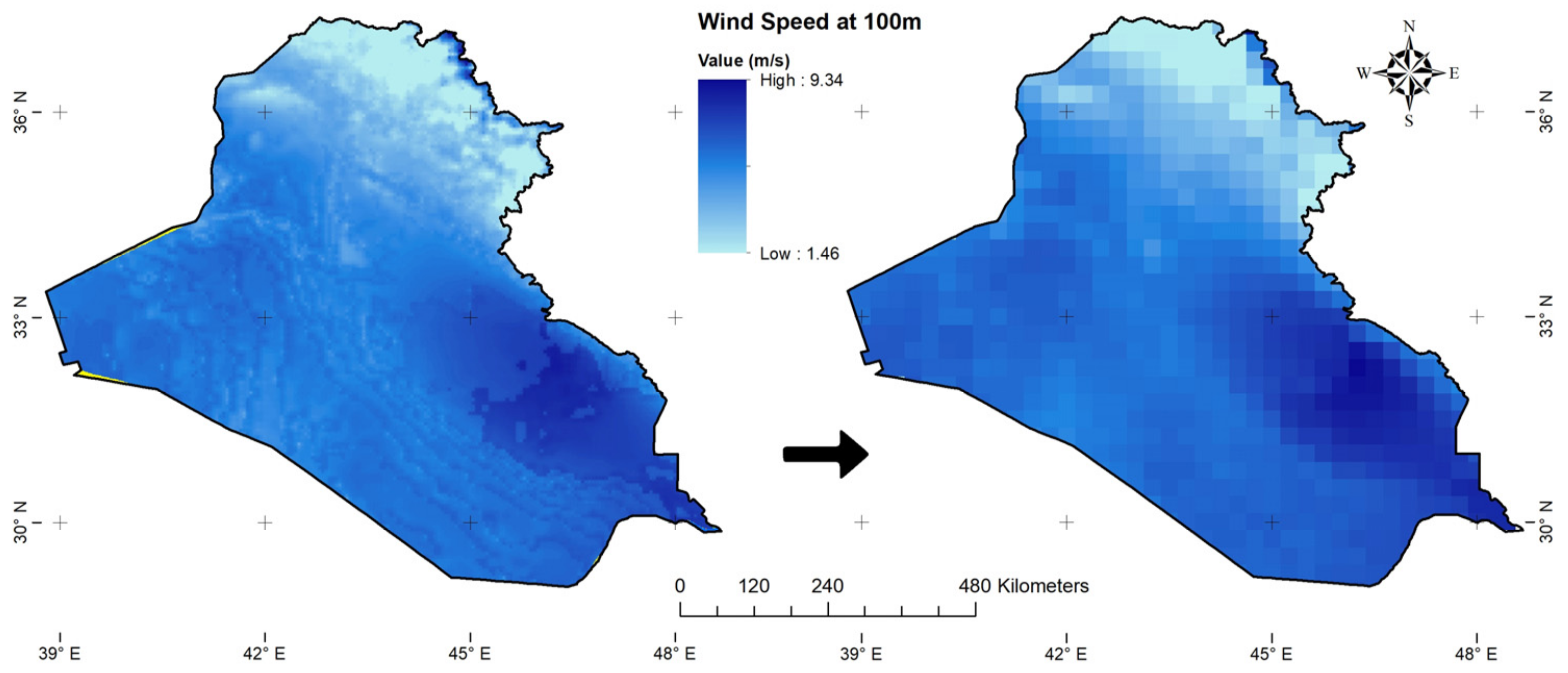
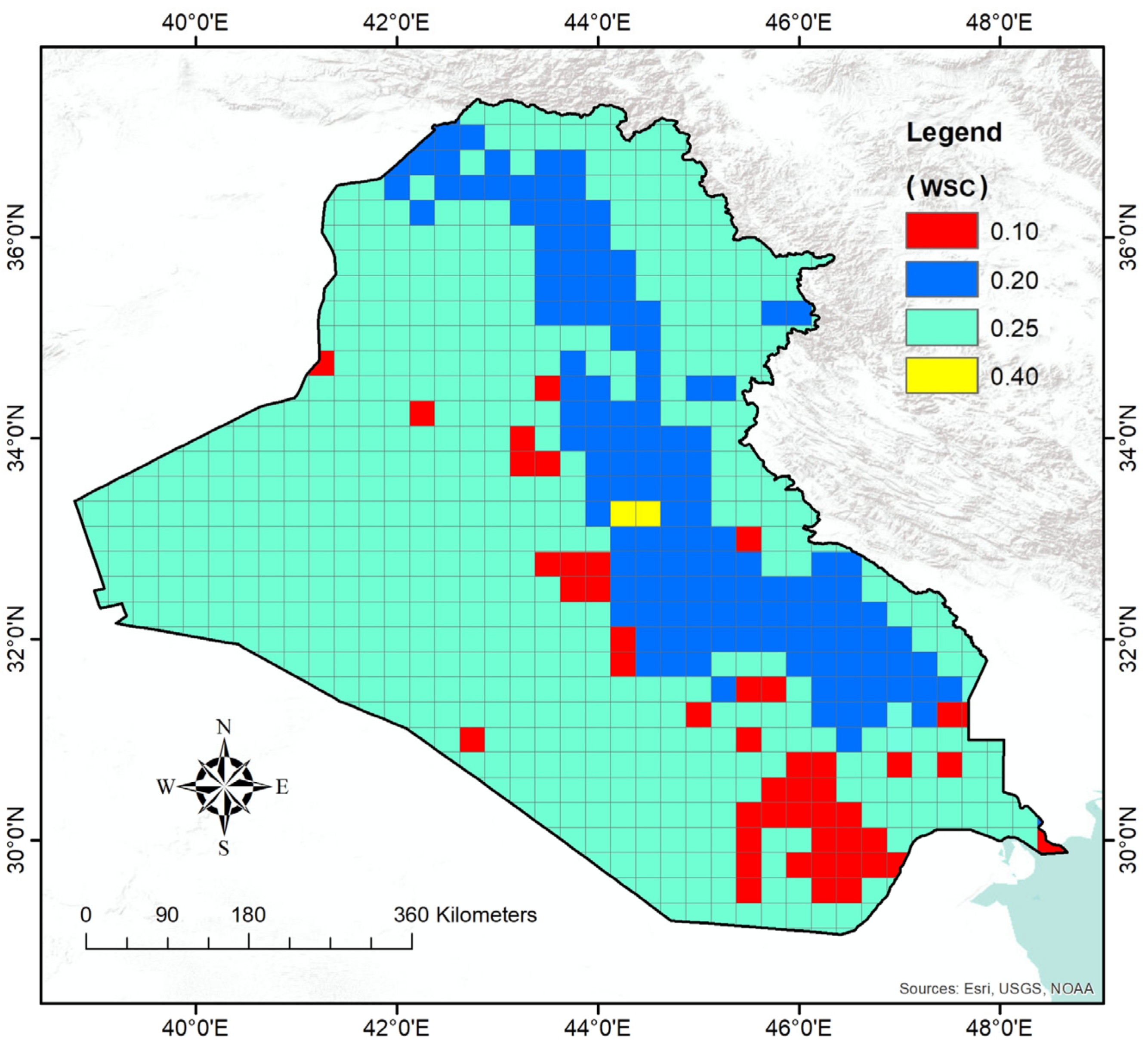
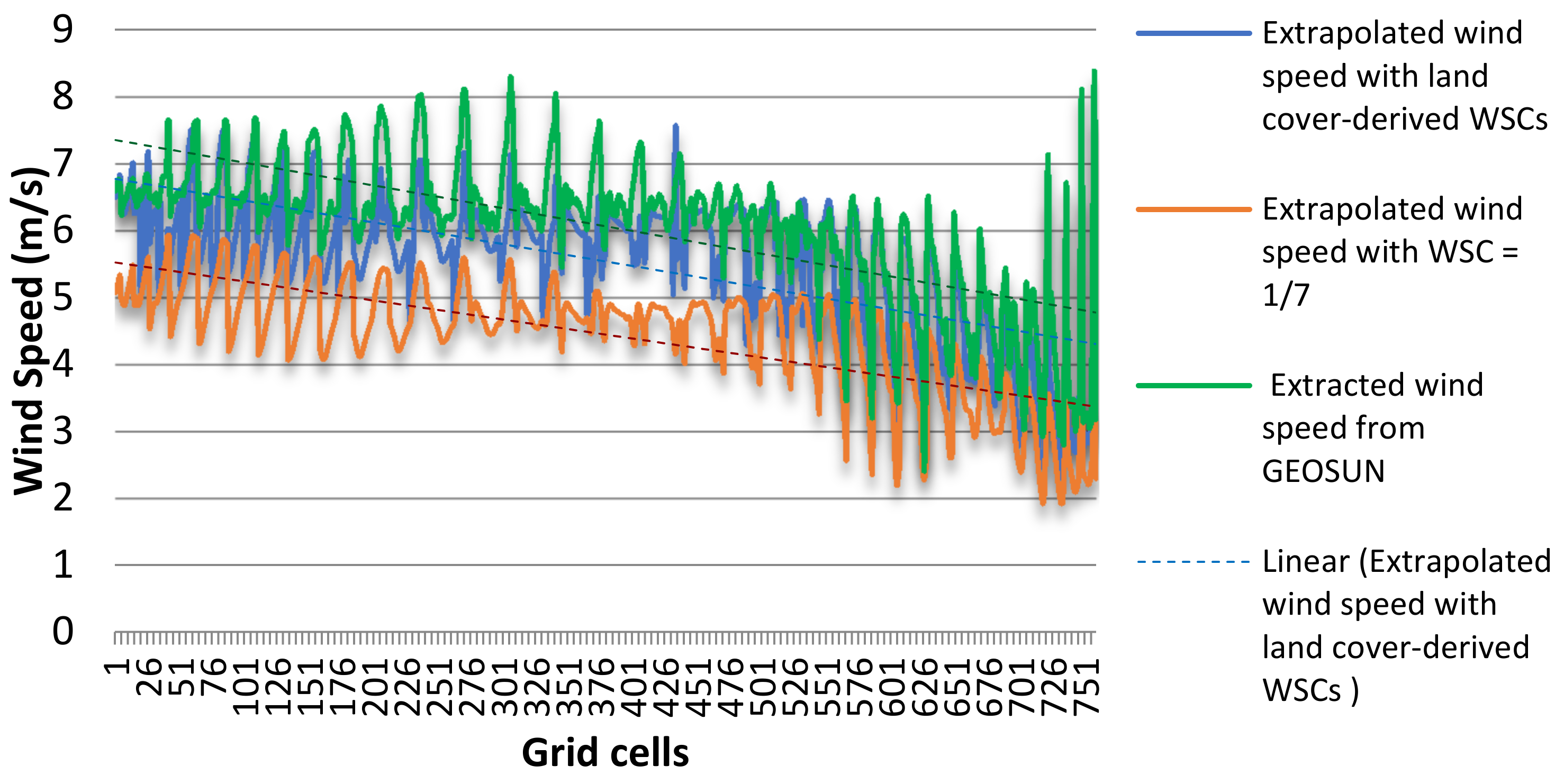
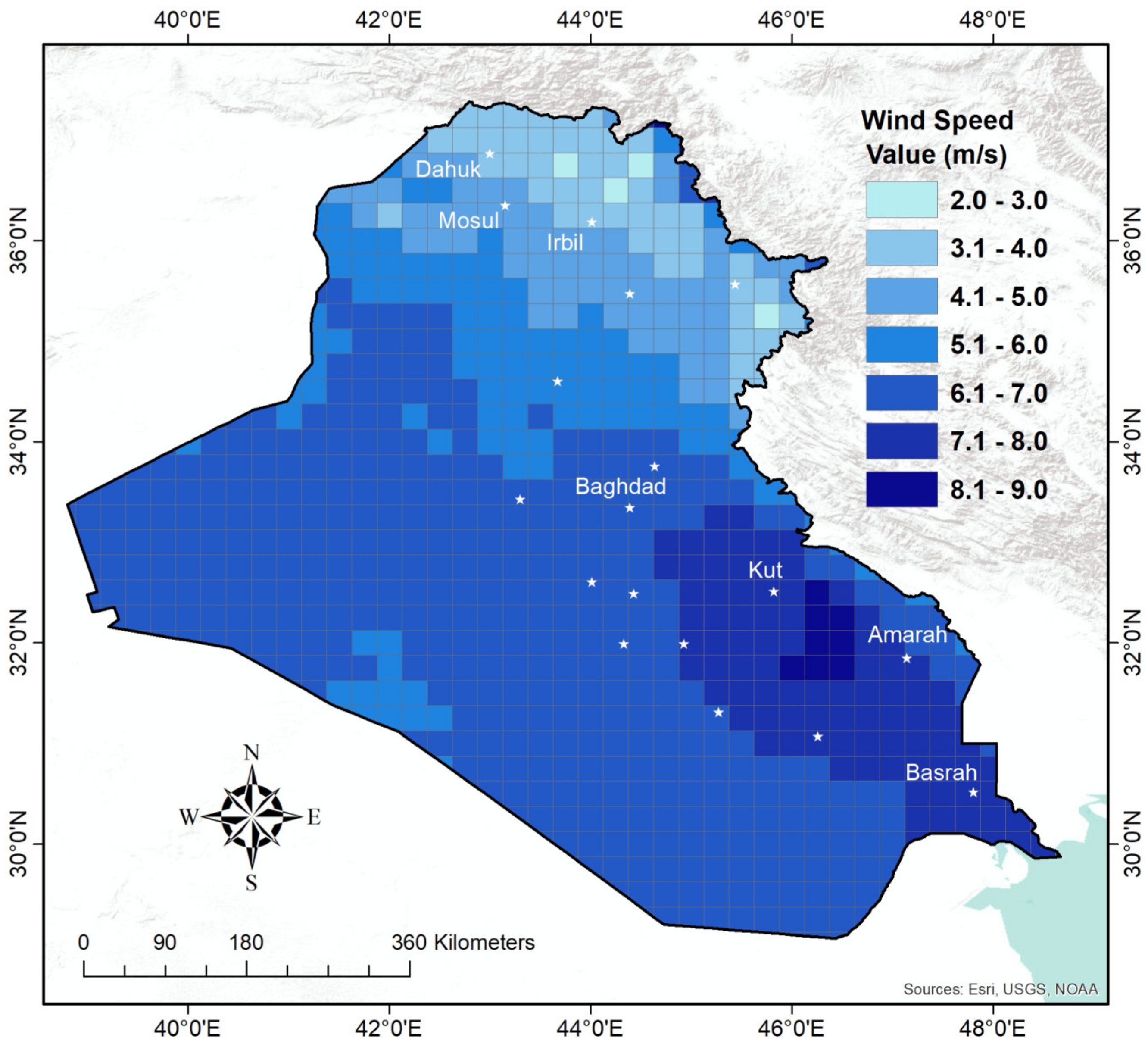

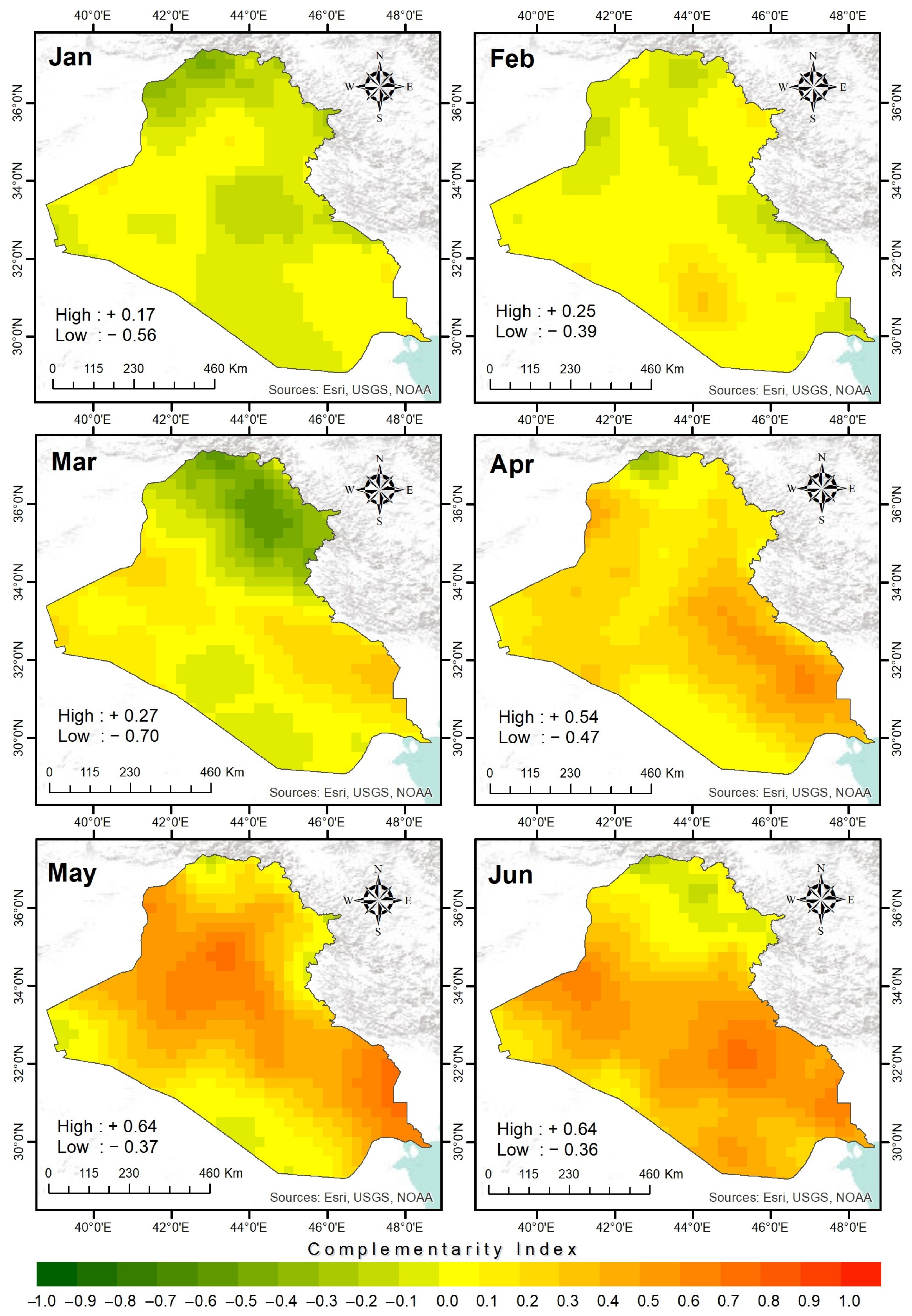

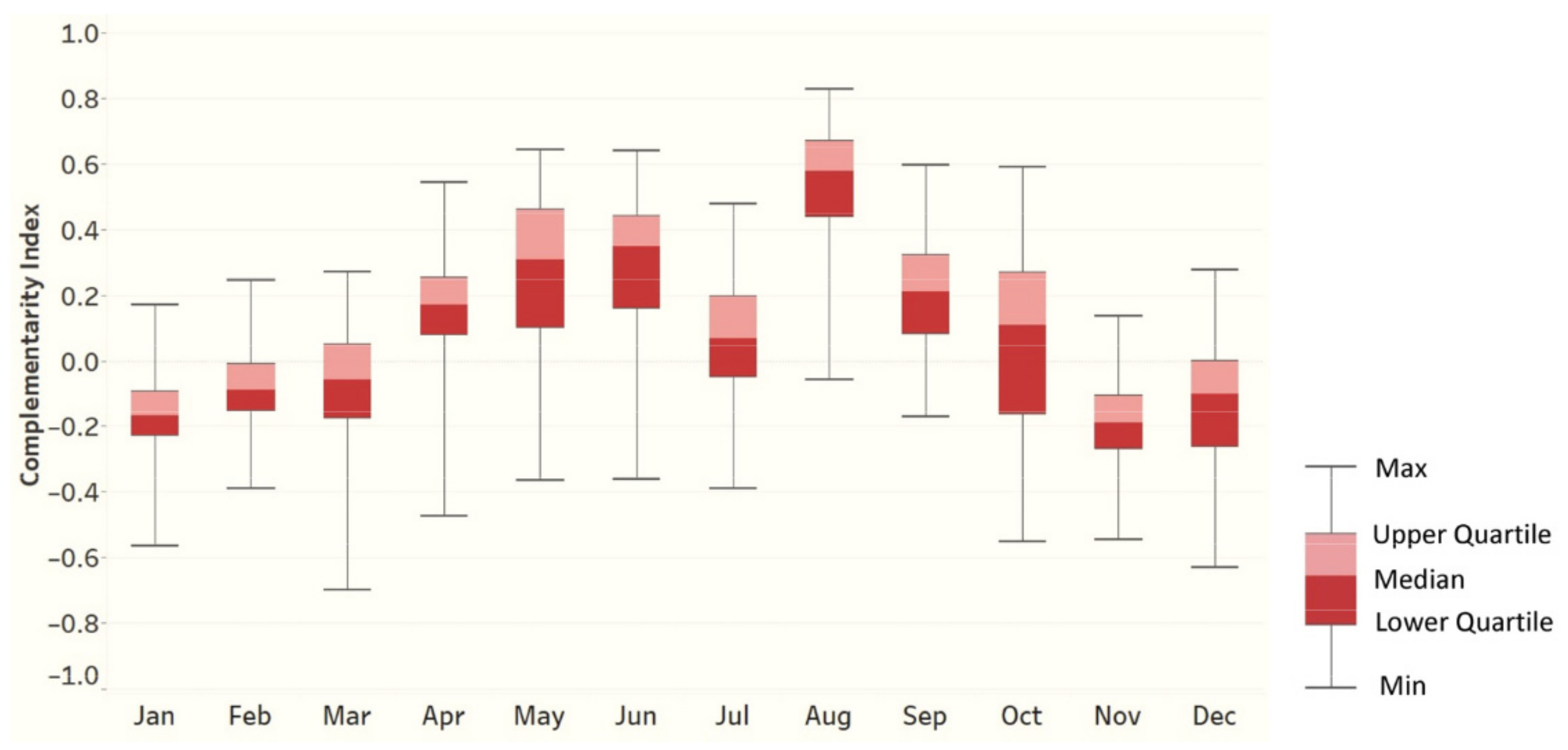
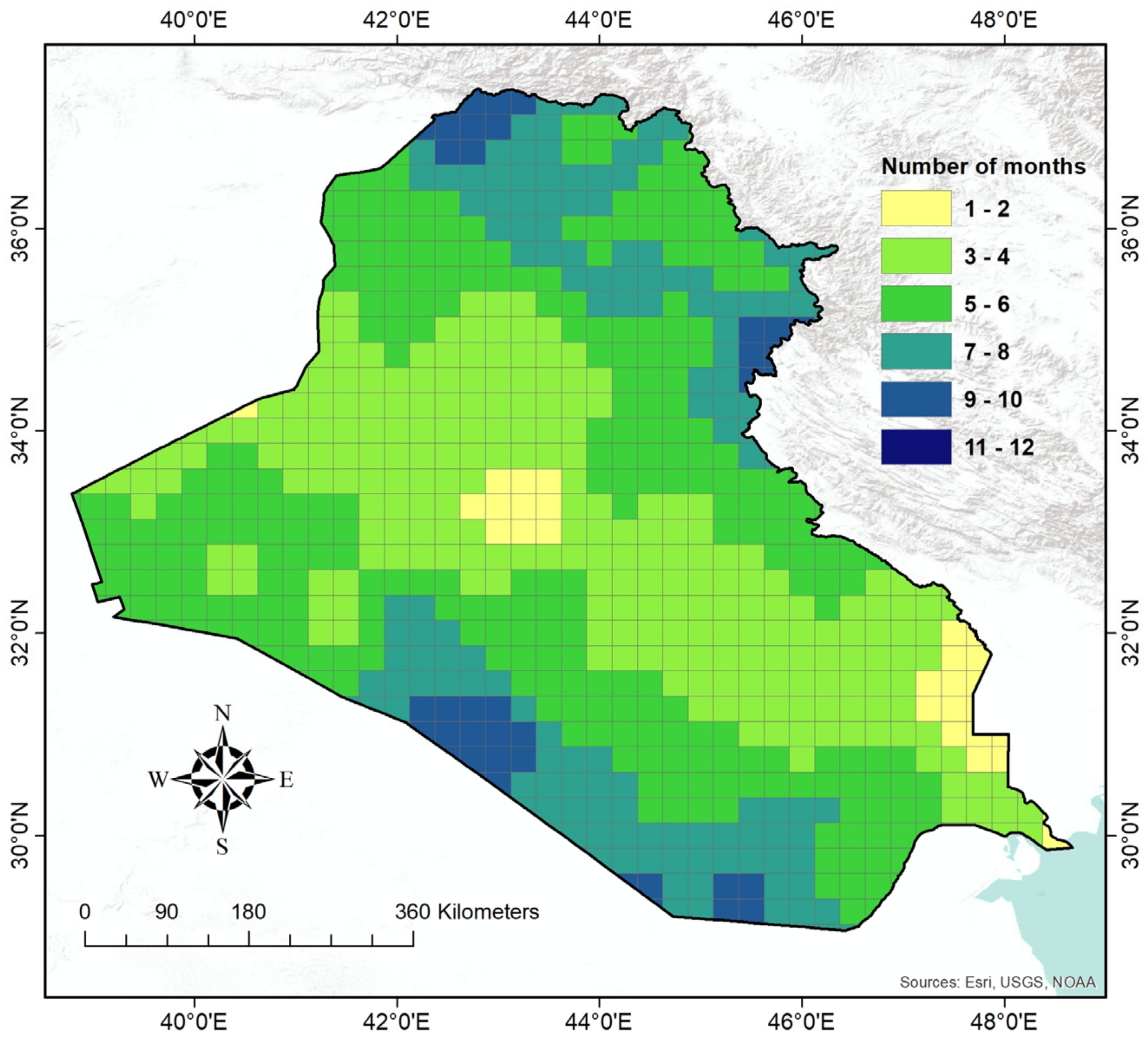
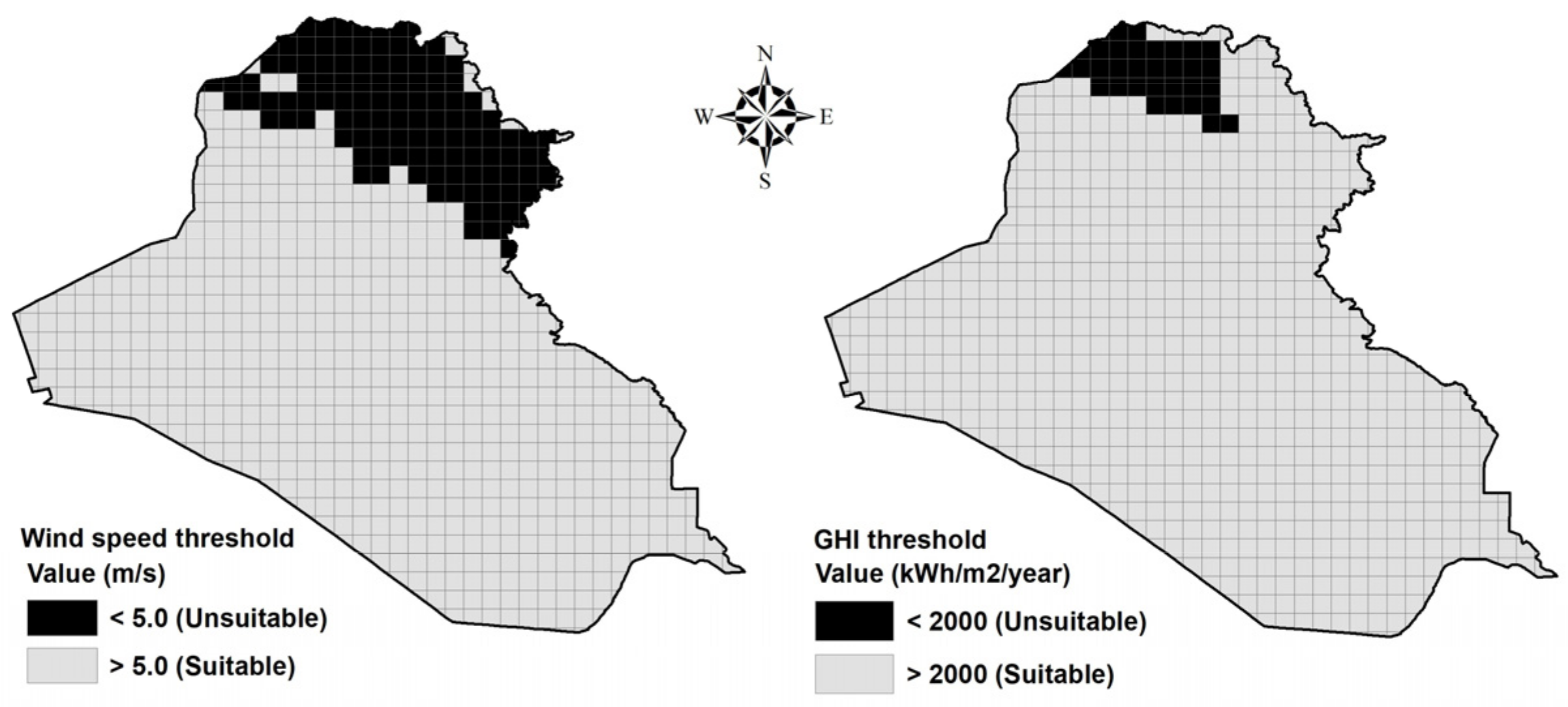
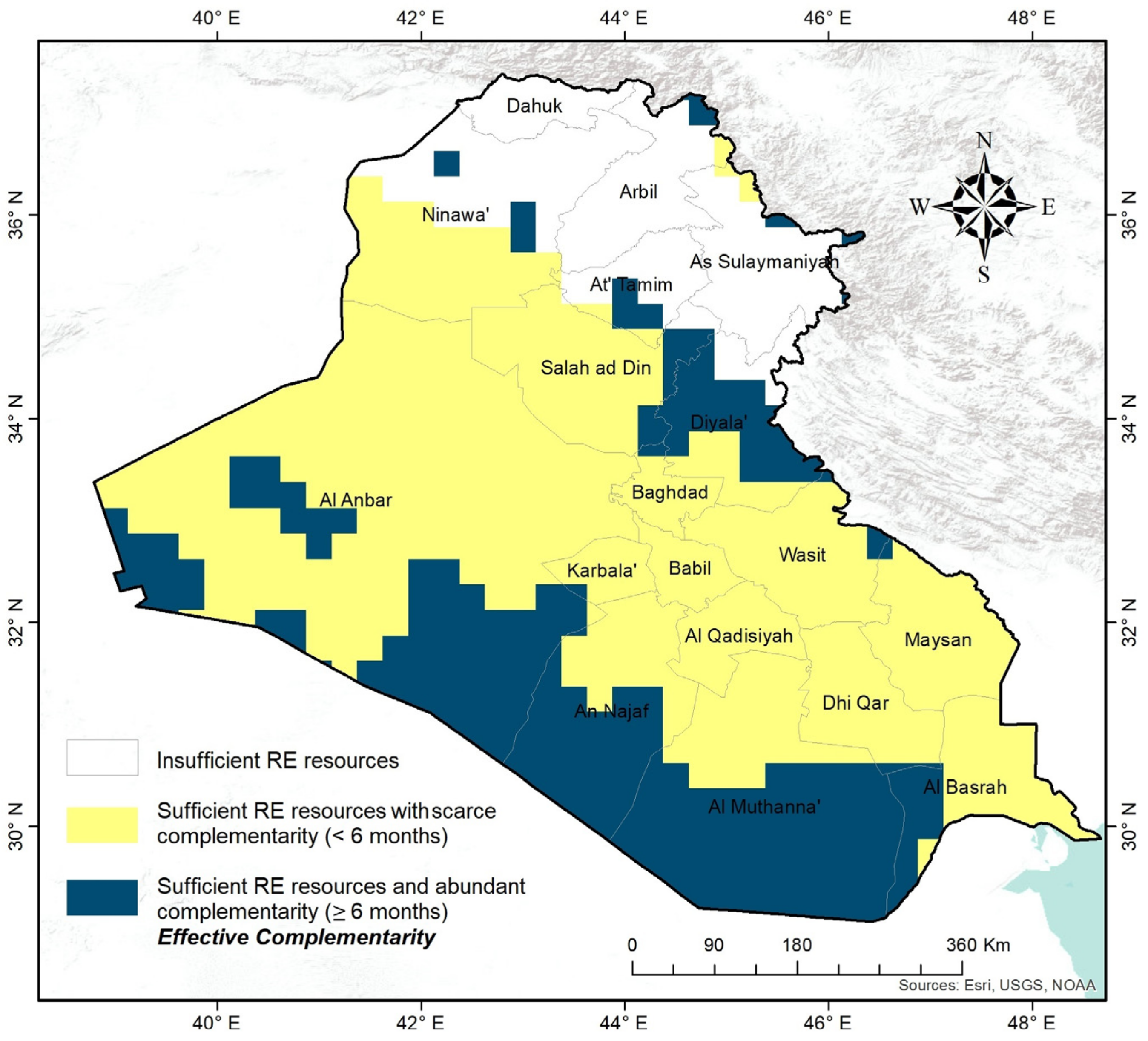
| Landscape Type | WSC |
|---|---|
| Smooth hard ground, calm water | 0.1 |
| Tall grass on level ground | 0.15 |
| High crops, hedges and shrubs | 0.2 |
| Wooded countryside, many trees | 0.25 |
| Small town with trees and shrubs | 0.3 |
| Large city with tall buildings | 0.4 |
| Complementarity Index (CI) Value | Interpretation |
|---|---|
| 0.9 ≤ CI ≤ 1.0 | Very strong similarity |
| 0.6 ≤ CI ≤ 0.9 | Strong similarity |
| 0.3 ≤ CI ≤ 0.6 | Moderate similarity |
| 0.0 ≤ CI ≤ 0.3 | Weak similarity |
| −0.3 ≤ CI ≤ 0.0 | Weak complementarity |
| −0.6 ≤ CI ≤ −0.3 | Moderate complementarity |
| −0.9 ≤ CI ≤ −0.6 | Strong complementarity |
| −1.0 ≤ CI ≤ −0.9 | Very strong complementarity |
| Month | Negative Correlation Value | p-Value | Decision |
|---|---|---|---|
| Jan | −0.56 | 0.0016 | Significant |
| Feb | −0.39 | 0.0489 | Significant |
| Mar | −0.7 | 0.0000 | Significant |
| Apr | −0.47 | 0.0116 | Significant |
| May | −0.37 | 0.0482 | Significant |
| June | −0.36 | 0.0599 | Not significant |
| July | −0.39 | 0.0365 | Significant |
| Aug | −0.06 | 0.7572 | Not significant |
| Sep | −0.17 | 0.3871 | Not significant |
| Oct | −0.55 | 0.0020 | Significant |
| Nov | −0.54 | 0.0030 | Significant |
| Dec | −0.63 | 0.0003 | Significant |
| Complementarity Level/Month | Weak | Moderate | Strong | Total Area Percentages |
|---|---|---|---|---|
| Jan | 85% | 9% | 0% | 94% |
| Feb | 77% | 4% | 0% | 81% |
| Mar | 45% | 15% | 4% | 64% |
| Apr | 11% | 2% | 0% | 13% |
| May | 15% | 1% | 0% | 16% |
| Jun | 14% | 1% | 0% | 15% |
| Jul | 35% | 2% | 0% | 37% |
| Aug | 2% | 0% | 0% | 2% |
| Sep | 10% | 0% | 0% | 10% |
| Oct | 26% | 12% | 0% | 38% |
| Nov | 78% | 16% | 0% | 94% |
| Dec | 54% | 19% | 2% | 75% |
Publisher’s Note: MDPI stays neutral with regard to jurisdictional claims in published maps and institutional affiliations. |
© 2021 by the authors. Licensee MDPI, Basel, Switzerland. This article is an open access article distributed under the terms and conditions of the Creative Commons Attribution (CC BY) license (https://creativecommons.org/licenses/by/4.0/).
Share and Cite
Sachit, M.S.; Shafri, H.Z.M.; Abdullah, A.F.; Rafie, A.S.M. Combining Re-Analyzed Climate Data and Landcover Products to Assess the Temporal Complementarity of Wind and Solar Resources in Iraq. Sustainability 2022, 14, 388. https://doi.org/10.3390/su14010388
Sachit MS, Shafri HZM, Abdullah AF, Rafie ASM. Combining Re-Analyzed Climate Data and Landcover Products to Assess the Temporal Complementarity of Wind and Solar Resources in Iraq. Sustainability. 2022; 14(1):388. https://doi.org/10.3390/su14010388
Chicago/Turabian StyleSachit, Mourtadha Sarhan, Helmi Zulhaidi Mohd Shafri, Ahmad Fikri Abdullah, and Azmin Shakrine Mohd Rafie. 2022. "Combining Re-Analyzed Climate Data and Landcover Products to Assess the Temporal Complementarity of Wind and Solar Resources in Iraq" Sustainability 14, no. 1: 388. https://doi.org/10.3390/su14010388
APA StyleSachit, M. S., Shafri, H. Z. M., Abdullah, A. F., & Rafie, A. S. M. (2022). Combining Re-Analyzed Climate Data and Landcover Products to Assess the Temporal Complementarity of Wind and Solar Resources in Iraq. Sustainability, 14(1), 388. https://doi.org/10.3390/su14010388








